- Images
- Blog
- Tools
- Questar
- The Questar telescope
- Questar resource links
- Search for Questar info
- 172mm Focal Reducer
- Afocal adapter for point and shoot camera
- Camera adapter lengths
- Camera adapter threading
- Camera connection
- Camera focusing
- Custom counterweight
- Drift Alignment Joy
- Finder Eyepiece Compatibility
- The Questar Moon 1981
- Questar Powerguide II Battery Life
- Questar Zone, How to Service Videos
- Red Dot finder mount for Questar
- Questar Viewing Table
- Wedge mounts
- White light solar filters comparison
- How to
- Get started in astronomy
- Astro RaspberryPi Camera and kin, the ASIAir and StellarMate
- Blind Smart-phone Equatorial Wedge or GEM Polar Alignment
- Camera phone adapter
- Celestron FirstScope with equatorial tripod mount
- Coat Pocket Astrophotography
- Day-lapse Images of Earthshine on the Crescent Moon
- Dobsonian Carrying Case
- DSO Astrophotography without a Telescope
- DSO imaging without a star tracker
- Estimating image resolution
- Lunar Eclipse Photography
- Moon photography - a dozen ways to shoot the Moon
- Meteor shower photography & planning
- Matching image sensor size to telescope resolution
- Narrow band imaging with color cameras
- Planetary Image Workflow
- Print and Display Astrophotography
- Observing
- Events
- More
- About
- Contact
Celestron FirstScope with equatorial tripod mount
The Celestron 76mm FirstScope is a table top single arm mini-Dobsonian telescope that is very inexpensive at about $50 list. It's occasionally less than $40 on sale. Like all Dobs, an inexpensive Alt-Az mount allows the manufacturer to provide a solid, easy to use, mount, along with fairly good optics, at a reasonable cost. A table top mount limits use to where a table is available. With the simple inexpensive adapter described below, a FirstScope or similar table top telescope can be used anywhere with a sturdy camera tripod. With an additional minor modification to the base of the FirstScope, it can be polar aligned and used in an equatorial orientation.

What you get
A bright (f/4) short focal length (300mm) wide field reflecting telescope with a spherical mirror. The spherical mirror guarantees some geometric aberration off axis. Collimation is easy to adjust at the secondary.
The two included eyepieces are very inexpensive 20mm and 4mm. The 4mm has too little eye relief to be useful and both have a small apparent field of view.
Celestron's optional accessory package includes a couple more cheap eyepieces and a straight through finder. I don't think that these are a good choice and suggest better alternatives below.
The Good News
This scope is a lot of fun for a very low price. You can see Jupiter with its moons and the rings of Saturn, but without much detail. Large deep sky targets like the Andromeda Galaxy and Orion Nebulae are within reach. This scope does better with wide field views of large open clusters like the Pleiades and Bee Hive clusters and is great for scanning through the Milky Way. It's rugged but small and light enough for frequently casual use. You can give it to a young child without worrying about the cost of an accident. For the price of inexpensive binoculars, you get a brighter view in a mounted telescope, which makes it easier to aim and share the view with others.
The short focal length gives a wide field of view which makes it easy to find things. Closer up views of the moon or planets require either short focal length eyepieces with their limited eye relief or a Barlow lens.
The eye pieces are standard 1.25” eyepieces and easily upgraded to Plössl eyepieces with a much wider field of view than the ones included.
Eyepieces
Upgrading the eyepieces is easy and the wider FOV and better eye relieve have a big impact. Two inexpensive Plössl eyepieces will cost about the same as the FirstScope, but they can be used with any quality telescope. Heavy high end eyepieces might improve the view near the edge of the field of view in a fast scope like this, but the FirstScope is too light to handle them well and limited by its spherical primary.
Expect to spend about $25 each for good generic Plössl eyepieces.
Finder
Avoid cheap straight through telescopic finders which are very hard to use. With a wide field scope like this a simple finder made from a straw or wire will work fine. A better option is a Celestron red dot reflex finder that fits. It is much easier to use and only about $15.
Tripod Alt-Az Mount
The table top design is great when an outdoor table is available, but very limited otherwise. For use for sidewalk astronomy or star parties, I needed a tripod mount. I settled on a simple design which mounts a tiny table on a standard tripod with three holes for the feet of the FirstScope. I started out with about a 8” square piece of 7/16” plywood. Next I drilled 3 1” holes 5 7/16” apart for the triangular legs. A 1/4x20 tpi T-nut placed in the center allows the adapter to be mounted on a standard camera tripod. I added an ARCA Swiss dove tail plate to match my tripods.
Tripod adapter top view:
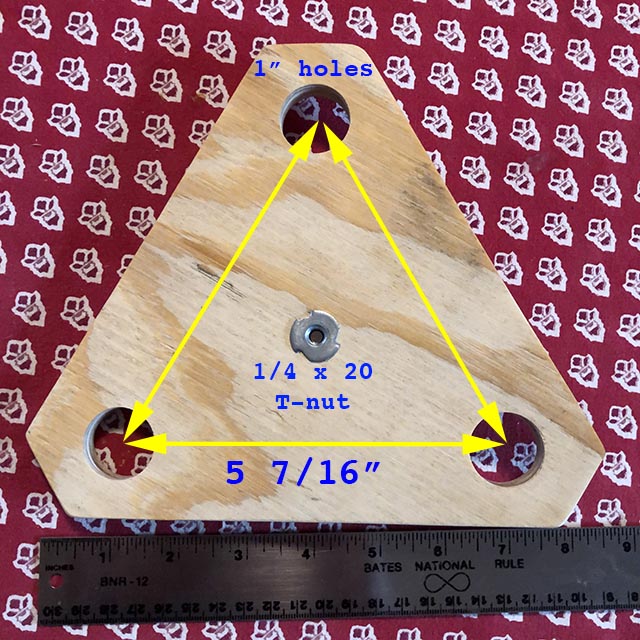
Tripod adapter bottom view with dovetail plate:
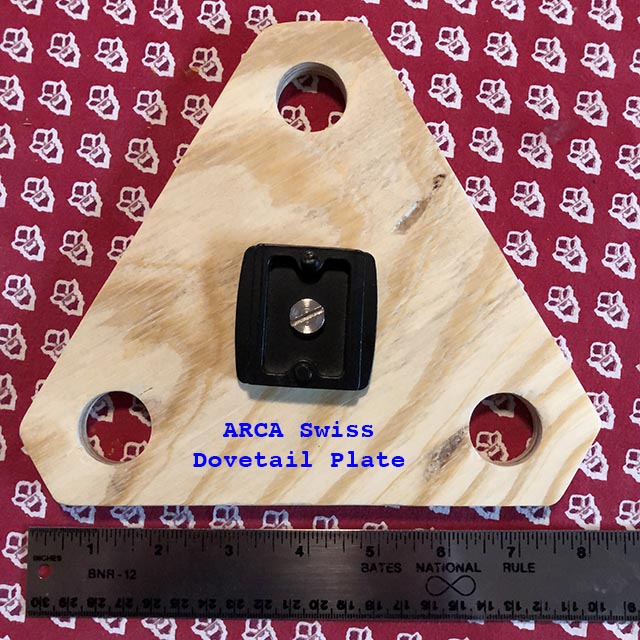
Tripod mounted FirstScope in sidewalk astronomy action:
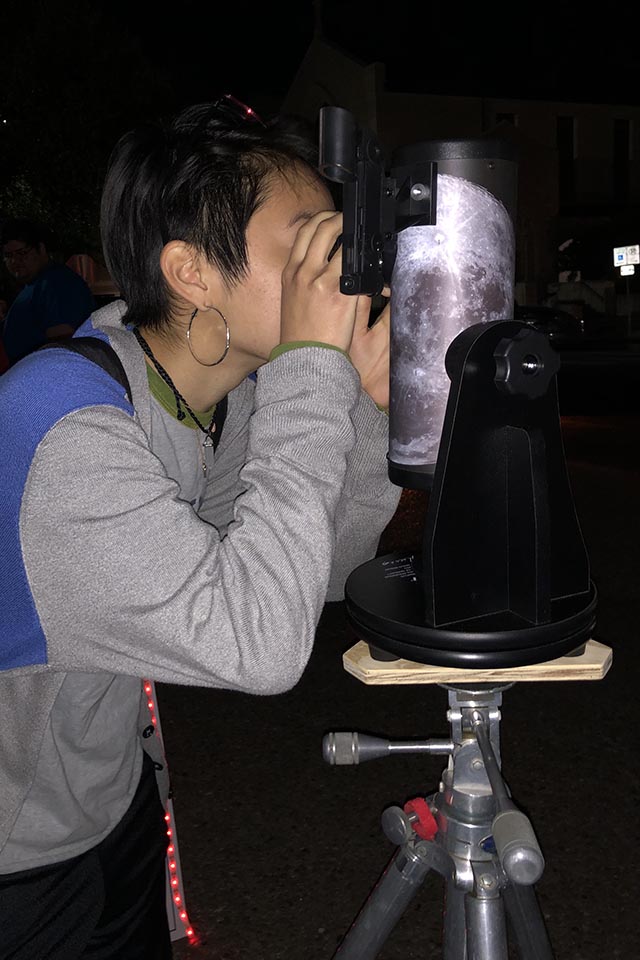
Equatorial Mount
An equatorially aligned mount allows stars to be tracked with motion along the R.A. axis. An Alt-Az mount can be converted to an equatorial mount by tilting the base with a wedge or other altitude adjustment to align the azimuth axis with the earth's. This isn't normally done with a Dobsonian mount because of the large weight and balance issues. It's quite feasible with a small table top telescope like the FirstScope.
Depending on the tripod mount that you use to function as your wedge, you might be able to do it without an adapter, by simply adding an 1/4x20 T-nut to the bottom circular base plate of the FirstScope azimuth bearing. For my setup I use a modification of the Alt-Az adapter plate to avoid conflicts between the long feet on the FirstScope base and the tripod head.
Gravity isn't sufficient to hold the telesope to the adapter plate as it is in the horizontal Alt-Az configuration. A 1/4x20 bolt is used to hold the two together. I removed the FirstScope base plate with the feet. I mated the feet to my adapter plate and drilled a single 19/64 inch hole to seat the 7/16" 1/4x20 T-nut in the FirstScopbe base and align a through hole in the adapter plate for for the 1/4x20 thumb bolt. Here is the modified FirstScope Az bearing base plate with the T-nut:

The adapter can be mounted to the dovetail or tripod screw with the same T-nut as the Alt-Az configuration. However, the balance point is shifted away from the center of the mount when the mount is tilted for porlar/equatorial alignment. I drilled a second 19/64" hole for another 7/16" 1/4x20 T-nut near the bottom edge of the adapter plate for better balance. The adapter plate modified for equatorial use is show below from the top and bottom views:

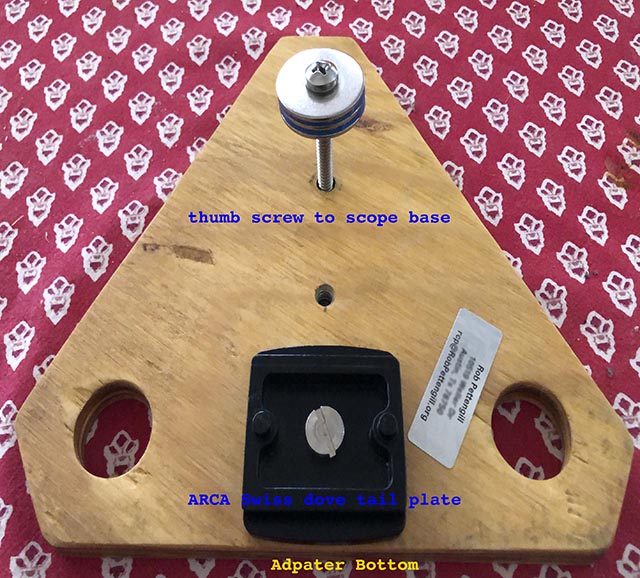
The FirstScope mounted for equatorial use is shown below:
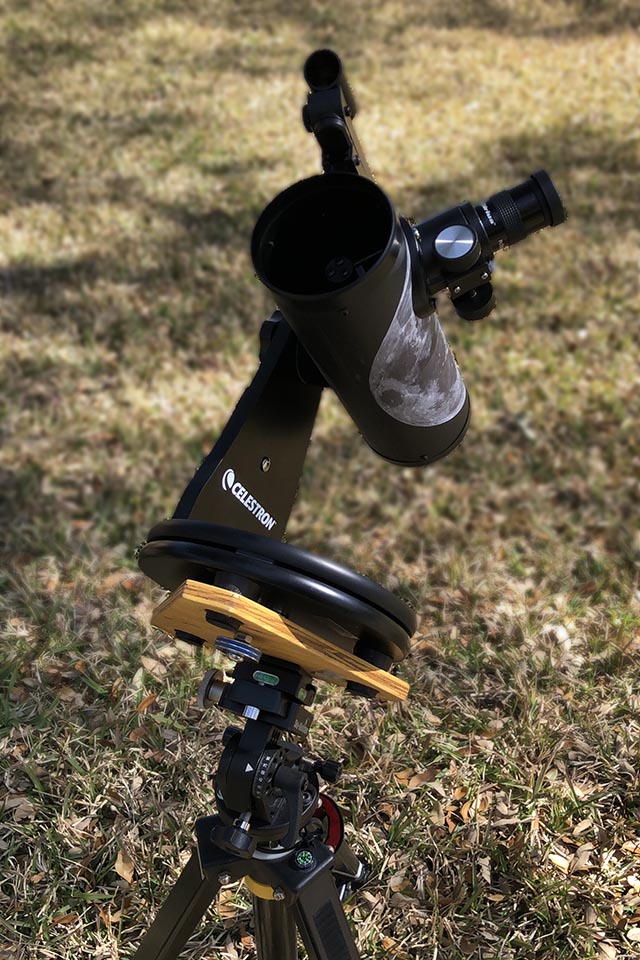
Other low cost telescope alternatives
I've written a guide to choosing a starter telescope. It gives guidelines and suggests some more capable and still moderately priced alternatives to the FirstScope.
Content created: 2019-03-15 and last modified: 2020-05-20
Comments
![]() Submit comments or questions about this page.
Submit comments or questions about this page.
By submitting a comment, you agree that: it may be included here in whole or part, attributed to you, and its content is subject to the site wide Creative Commons licensing.

How to
Starter telescopes for beginners
Getting started in astrophotography?
Choose & setup a camera for astrophotography
Astro RaspberryPi Camera and kin, the ASIAir and StellarMate
Blind Smart-phone Equatorial Wedge or GEM Polar Alignment
Celestron FirstScope with equatorial tripod mount
Day-lapse Images of Earthshine on the Crescent Moon
DSO Astrophotography without a Telescope
DSO imaging without a star tracker
Overview & equipment for lunar eclipse photography
Framing and tracking a lunar eclipse
Moon photography - a dozen ways to shoot the Moon
Meteor shower photography & planning
Matching image sensor size to telescope resolution
Narrow band imaging with color cameras
Print and Display Astrophotography

 Get started in astronomy
Get started in astronomy